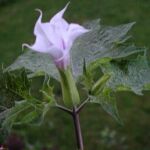| Drug Interactions: |
| Taking jimson weed with these drugs may increase the risk of anticholinergic effects (such as blurred vision, constipation, dry mouth, light-headedness, and urinary problems): |
| Amantadine, (Symmetral) |
Amitriptyline, (Elavil, Levate) |
Amitriptyline and Chlordiazepoxide, (Limbitrol) |
Amitriptyline and Perphenazine, (Etrafon, Triavil) |
| Amoxapine, (Asendin) |
Atropine, (Isopto Atropine, SalTropine) |
Benztropine, (Apo-Benztropine, Cogentin) |
Clidinium and Chlordiazepoxide, (Apo-Chlorax, Librax) |
| Clomipramine, (Anafranil, Novo-Clopramine) |
Cyclobenzaprine, (Flexeril, Novo-Cycloprine) |
Cyclopentolate, (Cyclogyl, Cylate) |
Desipramine, (Alti-Desipramine, Norpramin) |
| Dicyclomine, (Bentyl, Lomine) |
Diphenhydramine, (Benadryl Allergy, Nytol) |
Doxepin, (Sinequan, Zonalon) |
Fluphenazine, (Modecate, Prolixin) |
| Glycopyrrolate, (Robinul, Robinul Forte) |
Haloperidol, (Haldol, Novo-Peridol) |
Homatropine, (Isopto Homatropine) |
Hyoscyamine, (Hyosine, Levsin) |
| Hyoscyamine, Atropine, Scopolamine and Phenobarbital, (Donnatal, Donnatal Extentabs) |
Imipramine, (Apo-Imipramine, Tofranil) |
Ipratropium, (Atrovent, Nu-Ipratropium) |
Iproniazid, (Marsilid) |
| Lofepramine, (Feprapax, Gamanil) |
Loratadine, (Alavert, Claritin) |
Melitracen, (Dixeran) |
Moclobemide, (Alti-Moclobemide, Nu-Moclobemide) |
| Nortriptyline, (Aventyl HCl, Pamelor) |
Oxitropium, (Oxivent, Tersigat) |
Phenelzine, (Nardil) |
Prifinium, (Padrin, Riabel) |
| Prochlorperazine, (Compazine, Compro) |
Procyclidine, (Kemadrin, Procyclid) |
Propantheline, (Propanthel) |
Protriptyline, (Vivactil) |
| Scopolamine, (Scopace, Transderm Scop) |
Selegiline, (Eldepryl) |
Tiotropium, (Spiriva) |
Tolterodine, (Detrol, Detrol LA) |
| Tranylcypromine, (Parnate) |
Trihexyphenidyl, (Artane) |
Trimethobenzamide, (Tigan) |
Trimipramine, (Apo-Trimip, Surmontil) |
| Taking jimson weed with these drugs may decrease the action of the drug: |
| Chlorpromazine, (Largactil, Thorazine) |
Fluphenazine, (Modecate, Prolixin) |
Mesoridazine, (Serentil) |
Perphenazine, (Apo-Perphenazine, Trilafon) |
Prochlorperazine, (Compazine, Compro) |
| Promethazine, (Phenergan) |
Thiethylperazine, (Torecan) |
Thioridazine, (Mellaril) |
Thiothixene, (Navane) |
Trifluoperazine, (Novo-Trifluzine, Stelazine) |
|

